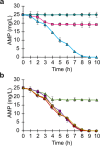Removal of Ampicillin with Nitrifying Cultures in a SBR Reactor
- PMID: 39786633
- PMCID: PMC11985629
- DOI: 10.1007/s12010-024-05165-1
Removal of Ampicillin with Nitrifying Cultures in a SBR Reactor
Abstract
The presence of antibiotics in wastewater discharges significantly affects the environment, mainly due to the generation of bacterial populations with multiple antibiotic resistances. The cometabolic capacity of nitrifying sludge to simultaneously remove ammonium (NH4+) and emerging organic contaminants (EOCs), including antibiotics, has been reported. In the present study, the removal capacity of 50 mg ampicillin (AMP)/L by nitrifying cultures associated with biosorption and biotransformation processes was evaluated in a sequencing batch reactor (SBR) system. The contribution of nitrifying enzymes (ammonium monooxygenase (AMO) and nitrite oxidoreductase (NOR)) and β-lactamases in AMP biodegradation was evaluated using specific inhibitors in batch cultures. AMP was 100% eliminated after 5 h since the first cycle of operation. The sludge maintained its ammonium oxidizing capacity with the total consumption of 102.0 ± 2.5 mg NH4+-N/L in 9 h, however, the addition of AMP altered the nitrite-oxidizing process of nitrification, recovering 30 cycles later at both physiological and kinetic level. The kinetic activity of the nitrifying sludge improved along the operating cycles for both AMP removal and nitrification processes. The elimination of 24% AMP was attributed to the biosorption process and 76% to biotransformation, wherein the AMO enzyme contributed 95% to its biodegradation. Finally, the repeated exposure of the sludge to AMP for 72 operating cycles (36 days) was not sufficient to detect β-lactamase activity. The cometabolic ability of ammonium-oxidizing bacteria for biodegrading AMP could be employed for bioremediation of wastewater.
Keywords: Ampicillin; Biosorption; Cometabolic biodegradation; Nitrifying sludge; Sequencing batch reactor.
© 2025. The Author(s).
Conflict of interest statement
Declarations. Ethics Approval: This research did not involve human participants and/or animals. Consent to Participate: Not applicable. Consent for Publication: Not applicable. Competing Interests: The authors declare no competing interests.
Figures



References
-
- Danner, M. C., Robertson, A., Behrends, V., & Reiss, J. (2019). Antibiotic pollution in surface fresh waters: Occurrence and effects. Science of the Total Environment,664, 793–804. 10.1016/j.scitotenv.2019.01.406 - PubMed
-
- Imwene, K. O., Ngumba, E., & Kairigo, P. K. (2022). Emerging technologies for enhanced removal of residual antibiotics from source-separated urine and wastewaters: A review. Journal of Environment Management,322, 116065. 10.1016/j.jenvman.2022.116065 - PubMed
-
- Wang, Y., Liu, Y., Lu, S., Liu, X., Meng, Y., Zhang, G., Zhang, Y., Wang, W., & Guo, X. (2019). Occurrence and ecological risk of pharmaceutical and personal care products in surface water of the Dongting Lake, China-during rainstorm period. Environmental Science and Pollution Research,26, 28796–28807. 10.1007/s11356-019-06047-4 - PubMed
MeSH terms
Substances
Grants and funding
LinkOut - more resources
Full Text Sources

